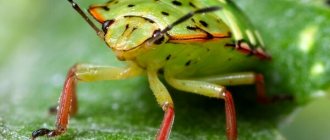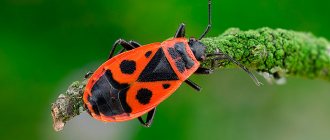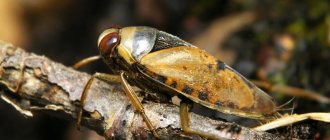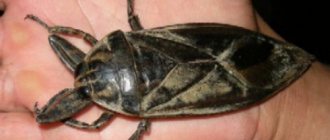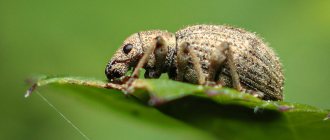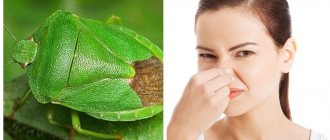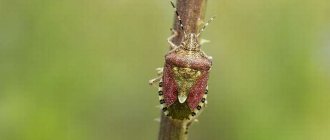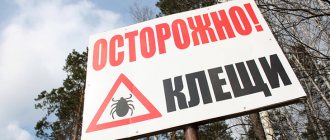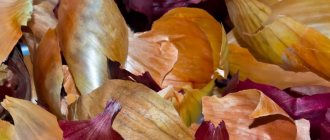During evolution, some insects changed the structure of the front pair of wings. The result was hard elytra filled with chitin. Because of this, the new order received the name “Coleoptera”, and popularly simply “beetles”. In terms of quantity and diversity, this is the largest group of living beings on the planet. Let's look at all the variety of species and in our review the most beautiful species of beetles living in nature.
Photos of the most beautiful species of beetles:
1
Ladybug / Coccinella septempunctata
Our list opens with the most common type of ladybugs. The elytra are colored red or orange with seven black dots.
The green beetle spread from the Far East to the Iberian Peninsula, in North Africa. In Russia it is found in the steppe zone, in gardens, and on the southern slopes of mountains covered with forests. Other species have spread throughout the planet except Antarctica.
This is a predator that eats aphids, whiteflies, and some types of scale insects. They were specifically brought to North America to reduce the aphid population. In the Northern Hemisphere, it displaces other species, as it is more distinguished by aggressive behavior.
2
Bark beetles
Previously, bark beetles were considered a separate subfamily, but now they are classified as weevils. Small beetles, pests of tree species. Adult beetles can make “ticking” sounds by tapping their heads against the walls of tunnels they have gnawed into wood - they can often be heard in old wooden houses at night. A number of species have a device for removing debris that interferes with movement along the passages - a depression in the elytra, which is called... a wheelbarrow! Yes, yes, friends, these are the only bugs with cars.
Great spruce beetle (lat. Dendroctonus micans)
Golden Bronzewort / Cetonia aurata
These are quite large beetles, growing up to 2.3 cm in length. There are 7 subspecies found in nature, which differ in body structure and color.
The bronze vulture has spread throughout Eurasia. You won't find them only in deserts and mountainous areas. It feeds on flowers of fruit trees, wild and cultivated plants. But it is not capable of causing significant damage to garden plants and agricultural crops.
Subspecies come in a variety of colors, from bronze to metallic grey. It was first described by Carl Linnaeus in 1758. We also call them cockchafers.
3
Use of entomophages on the site (with video)
In order for entomophagous insects to settle on the site, it is necessary to constantly carry out activities that can be roughly divided into two groups.
The first group of measures is aimed at attracting these creatures to the garden, and the second is aimed at keeping them on the site.
In order to attract beneficial insects, you need to plant honey plants. Moreover, it is best to plant these crops in 2-3 terms - so that they bloom throughout the season. Insects that are beneficial to hell and the garden prefer crops with small, “nondescript” flowers. In many cases, wild plants or perennial ornamental plants are used for this.
You can build flower beds on the site or plant the necessary crops between the rows (for example, dill).
It is best if the area is surrounded by a hedge consisting of wild shrubs at the flowering stage. It is not recommended to mow the grass, since you need to create a kind of ring from the grass growing in the area.
Sometimes you need to organize an “oasis” of wildlife on your property, which is a piece of uncultivated land with two or three flowering shrubs and one tall old tree.
There should be a non-drying shallow body of water, next to which insects will definitely settle.
Another effective way to “settle” entomophagous insects in your garden is to make wintering houses for them that imitate natural shelters.
Dry grass or leaves, pieces of tree bark and twigs are usually placed inside them. Houses are usually located near plants affected by pests - both garden crops and fruit and berry crops. Such structures, if approached creatively, can become an excellent decoration for the site.
Watch the video on how you can attract beneficial insects to your site:
The importance and economic feasibility of work on the introduction of beneficial organisms for the purpose of using their entomophages against pests and weeds is indisputable. However, this area of plant protection already requires new methods
It is necessary to purposefully unite research in the field of introduction under the leadership of a single scientific center equipped with modern equipment. This center, in addition to coordination, also performs control functions aimed at preventing the entry of new species of pests into a certain territory. At the same time, it is also necessary to organize expeditions to search for new useful species. In addition, it is important to expand the interstate exchange of beneficial organisms. All these actions will lead to a further increase in the share of the biological method in the system of measures that ensure plant protection.
The following describes in detail which beneficial entomophagous insects protect plants from pests and how to attract them to the garden.
Nut fruit / Curculio nucum
This beetle is also called the nut weevil, and it lives in the Dubrovnik forests of Europe, where hazel grows in the undergrowth.
It stands out in the order Coleoptera with an unusual proboscis. In females it is slightly longer than in males. There are two antennae on the proboscis. The body of the bug itself is black, but covered with yellowish scales. Because of this, its color appears golden.
Eats hazelnuts, hazel, and can feed on acorns. The female lays eggs in soft hazel fruits. In autumn, the larva gnaws through the shell and falls to the ground. There it burrows into the soil and overwinters.
By the way, on our website most-beauty.ru you can also admire the most beautiful weevils in the world.
4
Methods of fighting bedbugs with soldiers
Before processing, you should make sure that fire bugs are in charge of the area. This becomes clear from the obvious signs of the appearance of parasites.
Here they are:
- flowers and buds of plants fall off for no apparent reason.
- Cabbage leaves die or become covered with yellow spots.
- The beet tops are rolled into a tube.
- Umbrella plants dry out.
If the presence of soldiers is beyond doubt, you should immediately begin to destroy them. The ideal time for disinsection is early spring, since an unplanted area is most easily amenable to chemical treatment.
An excellent way to get rid of parasites is to regularly mow perennial weeds (for example, wormwood, quinoa). Firefighters often lay their larvae on the leaves of these plants, so such a radical technique will help prevent secondary infection.
The presence of legumes on the site is also undesirable, since red bugs can wait out the winter cold on them.
Chemicals
You need to get rid of soldier bugs without delay, as they reproduce very quickly and lay eggs. For thorough treatment, special insecticides are used.
Often, chemicals are sold in powder form that must be mixed with a small amount of water. The resulting mass is diluted in a bucket of water, then the areas affected by bedbugs are sprayed with this mixture.
When choosing a remedy against parasites, you should focus on its level of toxicity. The drug must be safe for both people and bees and animals. An important advantage is the absolute decomposition of the chemical without its accumulation in the soil.
Please note: pests quickly get used to any insecticides, which will subsequently affect the effectiveness of the treatment.
A completely environmentally friendly way is to collect firebugs by hand. This process is quite lengthy and is similar to collecting Colorado potato beetles. If parasites have infested a tree, you can purchase a special device at a hardware store - a hunting belt.
Folk remedies
Chemical insecticides can be replaced with folk remedies.
Here are some recipes that you can use at home:
- onion infusion. For cooking you will need 200 g. onion peels, which are filled with 10 liters of water. Infuse the mixture for 5 days, then strain. Spray the resulting mixture onto bedbug-affected trees and shrubs. The frequency of such processing is once every 5-6 days.
- Mustard solution. You need to add 100 grams of water. dry mustard powder. Bring the mixture to a porridge state, then dissolve in 10 liters of water. Use the resulting solution for spraying.
- Soap solution. To prepare it, you need to dissolve a certain amount of laundry soap (250-300 g) in 10 liters of water and spray the plants in the garden with this mixture.
The latter remedy is considered one of the most effective in the fight against soldier bugs. In addition, the soap solution repels many other pests.
If there is a grass lawn on the site, parasites can settle on it.
For such situations, the process of getting rid of bedbugs is as follows:
- tidy up the area and cut the grass.
- Sprinkle the grass with shavings of laundry soap.
- Water the lawn to help dissolve the soap.
Having treated the lawn in this way, it should be covered with a piece of flannel material. Firebugs will move from the grass to the fabric, where they can later be caught and destroyed.
Video
Soldiers attack cabbage
Hercules beetle / Dynastes hercules
The photo shows a very beautiful and unusual beetle that lives in Central and Latin America. This is a large species. Males grow up to 17 cm. Females are slightly smaller. But the wingspan reaches 22 cm.
The head is dark, and the entire body is covered with small red hairs. On the head of males there is a huge horn with teeth. Females do not have such a horn. Despite its menacing appearance, it is safe. Feeds on tropical fruits.
In search of food, it easily flies from tree to tree. Today the species is endangered and is listed in the Red Book of the International Organization for Conservation of Nature.
5
Dead eaters
The orderlies of our fields and forests are carrion eaters (Silphidae). A large number of these beetles accumulate near the corpses of dead animals, dig under the corpse, scooping out the soil from under it. Thus, they lower the corpse into the ground, where they then eat it together with their larvae. One of the few beetles that care for their offspring: adults feed the larvae, although they are capable of feeding on their own.
Gravedigger, or black-whiskered gravedigger (lat. Nicrophorus vespilloides)
Alpine longhorned beetle / Rosalia alpina
There is such an original beetle in the world that has spread throughout Europe. Forest beetles in the mountains rise to a height of 1,500 meters above sea level, which is why they received their species name.
Adults grow up to 3.5 cm in length. The body, head, limbs and antennae are covered with an original pattern. You won’t find specimens with the same color.
The barbel is the only representative of the relict genus Rosalia, which lives in the vast expanses of Europe. The number of the species is declining. The main cause of extinction is deforestation.
6
Prevention measures
Despite the very small size of carpet beetles and anthrenus beetles, fighting them takes a lot of time. But the fight may turn out to be useless if a number of measures are not taken that will protect a person’s home from their repeated invasion. That's why:
- All windows must be equipped with mosquito nets.
- Install fine-mesh grilles on all ventilation systems.
- If a cat or dog lives at home, then you need to constantly clean up their fur, which is the source of food for the anthrenuses.
- Get rid of old, unnecessary things in a timely manner. Even if no one wears clothes, they attract dust, and this is a favorable environment for these tiny insects.
- If things are sent for storage, then before that it is better to treat them with a 0.005% solution of permin, an anti-pediculosis agent. This will protect things from the appearance of moth larvae and carpet beetles.
- From time to time, all things must be taken outside (to the balcony) at any time of the year, but it is better when it is sunny and frosty in winter, and in summer, when there is real summer heat. This kills both larvae and adults. This simple procedure will help protect things from infection by many insects.
- After using a vacuum cleaner, it is advisable to take the dust bags out into the cold. Particular care should be taken to vacuum carpets and rugs, as well as thick curtains, covers on chairs and sofas.
- Periodically clean upholstered furniture using a steam generator, which will help get rid of small bugs hiding in the folds and seams of the upholstery material.
- Use garlic or bay leaves to repel insects, which can simply be placed in containers where food is stored.
- In order to block the paths of entry into the home for insects, it is necessary to seal all the cracks, cracks and just holes that often occur in rooms such as the kitchen, bathroom, and even in rooms. The builders could have left them when they were making the heating, water supply, gas and sewage systems.
The appearance of any insects, especially in large numbers, in a person’s home can be considered an emergency. Every housewife should have information about what insects can appear in the apartment and know what they look like. In most cases, these are harmful and dangerous insects, since they intend to spoil everything, in the literal sense of the word. In addition, they can infect household members with various, and sometimes very dangerous, ailments. Therefore, if you suspect the appearance of any pests, you should immediately try to get rid of them in any available way.
It is better to resort to chemicals in rather difficult situations when it is not possible to get rid of pests by other means. Most likely, the fight is being waged in the wrong direction and not in all possible, sometimes quite simple ways that require consistency, but some owners are simply not ready for this. You should also remember that it is better to take care in advance to ensure that pests cannot enter your home. Of course, it is impossible to completely protect yourself from this, but you should not leave any chance for pests and parasites.
Elephant beetle / Megasoma elephas
The giant from the Duplyaki family chose the rainforests of Latin America to live. Large populations are found in Mexico, Nicaragua, and Panama.
Males reach 17 cm in length, females no more than 8 cm. The body is black, and everything is covered with red hairs. On the small head of the male there is a horn directed forward. This is a nocturnal resident. It goes in search of food after dark, and during the day it hides under the bark or in the foliage of trees.
Biologists distinguish three subspecies. The first was discovered at the end of the 18th century, but the other two were discovered in the 20th and 21st centuries.
7
Features of character and lifestyle
Photo: Fireman beetle in nature
In appearance, the fireman beetle evokes only positive emotions. But its harmless appearance hides a real predator. Firefighter beetles spend almost all day hunting. They stalk their prey in flight, then grab it with their powerful jaws, bite it, and then consume it after exposure to venom. In warm weather, firemen can often be seen on various plants. There they not only bask in the sun, but can also have a snack. Insects gnaw only the fleshy parts of plants.
Firefighter beetles lead an active lifestyle. During the day they fly a lot, love to land and sit for a long time on plants, grass, flowers and fruit trees. These insects are attentive and have a good reaction. If any object approaches, they instantly fly into the sky. If it fails to fly away, the insect can pretend to be dead. To do this, it tucks its paws under itself.
Interesting fact: You should not try to pick up a fireman's beetle. He bites very painfully and releases a special odorous substance at his offender. The insect has sharp teeth and powerful jaws. The bite is quite painful.
Soft beetle larvae spend their day differently. They live on fallen leaves, soil or old wood. They overwinter under the roots of trees, buried deep in the soil or under foliage. The larvae have three pairs of legs, so they move easily and quickly. With the help of powerful jaws, they make their way, making tunnels in the tree. Little firemen feed on centipedes and worms. Outside the shelter, larvae appear very rarely. The only exception is the period of active snow melting. The larvae crawl out to escape the melt water.
Rhinoceros beetle / Oryctes nasicornis
There is an elephant, and there is also a rhinoceros beetle. It lives in the deciduous forests of Europe, but over time it has developed a taste for other natural landscapes.
It grows up to 4 cm in length, and can be recognized by the characteristic horn on its head. It resembles a rhinoceros horn, hence the species name. They crawl out of shelters at night, and during the day they prefer to hide in the foliage, under the bark of trees.
On the island of Crete, during archaeological excavations, terracotta figurines in the idea of rhinoceros beetles were found. Such figurines date back to 2000–1600 BC.
8
Attracting soft beetles
In order for firefighter beetles to become regulars and defenders of your site, there is no need to apply particularly complex measures. All natural farming activities are great for attracting these beneficial insects. We just need to act as it happens in nature:
- Do not dig the soil on the site.
- Do not rake leaves under wintering trees and shrubs, and certainly do not burn them, losing not only useful organic matter, but also natural protectors.
- Do not use pesticides in the garden, which destroy all living things, and ultimately us and our loved ones.
Look at nature, act according to the scenario of harmony and mutual assistance outlined by it.
Sacred Scarab / Scarabaeus sacer
In Ancient Egypt, if a scarab was encountered on the way of an army, it turned back. The most revered symbol in the mythology of Ancient Egypt.
Today, the habitat is limited to southern Europe, North Africa, and the steppe regions of Eastern Europe. It is found in Kazakhstan, Turkey, and on the islands of the Mediterranean Sea. The body color is black, and with age, adult specimens become shiny.
One of the features is the ability to roll manure balls. In many European countries, the scarab is listed in the Red Book.
9
Nutrition
The predatory nature of firefighter beetles manifests itself in the hunt for a variety of insects: aphids, caterpillars, small leaf beetles, and the larvae of other soft beetles. Organisms protected by a chitinous covering are too tough for the firefighter beetle.
Red-legged softies approach their prey closely or sit on it. They press with their jaws from all sides until the resistance stops. Sharp and strong sickle-shaped jaws, which are designed specifically for holding, not chewing, help preserve prey.
Injecting poison and digestive juice into the victim’s body helps convert what they catch into food. The diet includes insects whose size is smaller than the predator itself.
Many gardeners do not know about the benefits of firefighter and try to get rid of it, classifying it as a plant pest. It has been proven that the presence of red-legged softies on the site contributes to a good harvest.
Firefighter beetle larvae also follow the diet of predators. It is interesting that the number of garden pests destroyed by softfly larvae exceeds the imago, i.e. developed beetles. The larvae eat various centipedes, worms, and small insects.
What do firefighter beetles eat, besides small animals? If an excessive number of red-legged soft-bodied animals have gathered in one area, then the lack of animal food is compensated for by plant food.
Beetles bite off flowering buds and greenery of fruit crops, causing harm to gardeners and gardeners. This does not happen so often, so experts unanimously believe that the benefits of firefighter beetles are disproportionately greater than the harm.
Fireflies / Lampyridae
They may not be the most beautiful, but they have a feature that, in the opinion of most-beauty, makes them stand out in a huge family. These bugs glow in the dark.
They have special luminous organs - lanterns. Glow acts as a means of communication between individuals. Signals are divided into groups - protective, attractive, signals of agreement and refusal. The glow itself is a complex process of several chemical compounds.
The firefly family has more than 2,000 species. They settled on all continents except Antarctica. In Japan, there is even a special holiday in honor of these insects - Hotarugari.
10
Narynniki
Blister beetles (Meloidae) have bright, often spotted warning colors. The blood of these beetles contains cantharidin, a substance that causes deep ulcers on the skin.
Epicauta hirticornis
T-shirt scarred
Scented beetle / Calosoma sycophanta
The ground beetle family is represented by the beetle, which received its specific name due to its unusual color. Emits a sharp, unpleasant odor in moments of danger.
It has a characteristic greenish-blue color with a bright golden tint. They grow up to 35 mm in length. The beauty lives from 2 to 5 years. Leads a daily lifestyle. This is a dangerous predator that eats caterpillars and silkworms. Over the summer it can eat up to 300 caterpillars.
Settled throughout the south of Europe, Western Asia, and the countries of Southeast Asia. It is protected in many countries. The number directly depends on the number of caterpillars.
11
Why are moths dangerous not only for clothes?
When analyzing what other insects may live in your apartment, it is worth stopping at moths. The domestic pest causes significant damage not only to fur and wool items, but also to food products - mainly cereals. Clothes moths like to feast on clothes, and food moths like to feast on human food.
It is not difficult to recognize an adult moth - it is a miniature dark-colored butterfly. It should be remembered that the danger is not the butterfly in adulthood, but the caterpillars before the pupation period. It is the caterpillars that leave traces of their presence on food and clothing.
The easiest way to remove clothes moths from the house is with proven insecticidal agents, and also, if conditions allow, by increasing the air temperature to 70 degrees, or reducing it to a noticeable minus. Among the folk methods, it is worth noting those based on lavender, which will have an effect only at the initial stage of infection.
It’s easy to get rid of food moths by limiting access to food and removing infested ones.
Marbled beetle / Polyphylla fullo
A large representative of coleopteran insects of the Khrushchia subfamily. Adults grow up to 4 cm.
It is easy to recognize by its characteristic marble pattern. There are white spots of different shapes on the dark body. Because of this original coloring they received their specific name. At the front of the head are two large antennae.
A large beetle has spread throughout southern Europe. It feeds on leaves, flowers of fruit and agricultural plants. The larva happily eats plant roots.
How to get rid of skin beetles
To eliminate a parasite colony, first perform a thorough spring cleaning.
Arm yourself with a vacuum cleaner with a water filter and process all the hard-to-reach places, especially those where you have long wanted to, but never got around to looking. It will not be possible to remove the entire colony the first time; this procedure will have to be carried out every day for at least a week. If you use a regular vacuum cleaner, after each cleaning, immediately change the filter and throw it in a trash container outside before the insects crawl out. Beetles cannot tolerate sudden temperature changes. In winter, you can take all contaminated items out of your apartment into the cold for several hours. Return the items to the heat, and the next day repeat the freezing procedure. It is advisable to do this at least 4-5 times. It is very difficult to move heavy furniture - instead of cold, you can use heating using a steam generator. In this way, you can process building structures and other objects that cannot be taken to the balcony.
Physical methods will only help if you notice the parasites in time and the colony has not had time to firmly settle and multiply. If skin beetles have occupied the entire apartment, only chemistry can save you. First of all, carry out a general cleaning to destroy the maximum number of clutches, larvae and adults. Sprinkle boric acid or a product containing this compound under carpets and along baseboards. You can also put clothes and small items in bags and put the Executioner insecticide in them. For large objects and building structures against skin beetles, you can use Dichlorvos.
Advice
The resource VredStop.ru has collected information about the larvae of the leather beetle, which cause the main damage to things. They live in dark places and cannot tolerate light. When disinsection, pay maximum attention to the inner surfaces of cabinets, nooks and crannies of furniture and building structures.
Brazilian bigtooth woodcutter / Macrodontia cervicornis
One of the largest beetles in the world. Because of its large horns, it received a Latin name, which is translated into Russian as “large-toothed staghorn.”
Biologists recorded a maximum size of 178 mm. The stag-horned representative of the Coleoptera settled in the southern part of the South American continent. They feed on leaves and flower pollen. They easily split the bark of trees with their horns.
A very rare species. It is under guard. He has many natural enemies. Birds happily eat larvae, as well as adults.
13
Interesting Facts
In addition to its bright color, the insect is interesting because:
- The venom of the soft belly has a specific odor;
- the red spot on the pronotum is individual for each beetle, like fingerprints or the auricle of a person;
- the insect is not afraid of temperature changes; in temperate latitudes the beetle feels great;
- not afraid of insects and birds of prey, the main defense is poison;
- The saving grace for a firefighter can be the ability to pretend to be dead in case of danger;
- the insect is an excellent analogue to the chemical treatment of garden plants against pests;
- the beetle has no upper lip;
- It is not difficult to catch a beetle in flight; its movement speed is not high.
The fireman beetle will bring a lot of benefits in the garden and on the plot: it will rid plants of aphids and help cope with caterpillars and flies. However, large numbers of insects can destroy the harvest of some stone fruits; it is advisable to monitor their numbers.
Stag beetle / Lucanus cervus
And this stag is the largest in Europe. Males can grow up to 9.1 cm, females are smaller, only 7–7.5 cm. The range is limited to Europe and the countries of Western Asia. Has been spotted in North Africa.
Size and shape vary depending on habitat. They are nocturnal, but in some regions they go out in search of food during the day. It's beautiful to watch two stag beetles fight over territory.
This species is mentioned in the writings of Pliny, who was the first to describe its appearance and structure in his Natural History. The ancient inhabitants of the Apennine Peninsula made beautiful amulets from them.
?
What harm can insects cause?
Garden bugs are unpretentious eaters. For normal life, the juice of any plants is enough for them. They can obtain food from leaves, trunks, stems and fruits. The consequences for the land are disastrous. The seedlings slowly dry out and die over time, and their fruits become completely unsuitable for consumption.
Important! These parasites are absolutely safe for humans and cannot take up residence in any residential premises. If you do find this insect in your apartment, then you just need to take it outside, and the bug will not return.
Undoubtedly, there are parasites that cause more widespread damage to agricultural land than soldier bugs, but the latter can also cause a lot of trouble. This is due to their intensive reproduction and feeding habits - having gathered in large colonies, they do not leave young weak shoots a chance to survive. If the land is not enough for them to satisfy, then they can switch to the corpses of their fellow tribesmen, other insects and even vertebrates.
Attention! Even large grape plantations can suffer from the invasion of these pests. Insects destroy both stems and elite fruits.
Bottom line
Here we have presented a photo with the names of representatives of the Coleoptera order. To summarize, let us turn to the etymology of the word “beetles”. It comes from two ancient Greek words “scabbard” and “wing”. But Slavic is logically derived from the verb “buzz.” The editors of most-beauty.ru ask you to write in the comments what other beautiful species of beetles, in your opinion, should be included in this list.
And below we decided to post a few more beautiful photographs with different types of beetles:
That's all for now! We look forward to your comments.
Zlatki
Gold beetles (Buprestidae) are very beautiful. Golden, green, yellow, with multi-colored spots. All borers have a very durable shell. They feed on leaves or thin bark of plants, causing significant damage to plants. In sunny weather, beetles quickly run from one place to another along tree trunks heated by the sun; No wonder they are called “children of the sun.”
Chrysanthemum on a buttercup flower
Twirly
This family of small-sized water beetles (on average about 6 mm) includes several hundred species, mostly inhabiting tropical waters, but such beetles are also found in the northern regions, in particular in fresh water bodies near the Black Sea coast, in Sweden, Norway, Spain. And a couple of dozen species live in Russia.
Such beetles, like the previous ones, belong to the suborder of carnivores and feed on small aquatic life, not only alive, but also dead. Their way of digesting food is very interesting, because the main processes occur not inside, but outside their body. The spinners inject enzymes into their prey, which dissolves it, and then only suck it up.
The body shape of such creatures is oval, convex; The color is predominantly black and shiny. On the surface of the water they move energetically, quickly, stay in groups, constantly describing circles and dancing in circles without rest, for which the beetles got their name. And only sensing a threat, they dive into the water.
In addition, they can fly, as they are naturally endowed with membranous, well-developed wings. For their tirelessness, these waterfowl insects have been awarded the title of the fastest swimmers among their own kind. The largest species of such organisms are found in East Asia; their representatives can grow to a size of two or more centimeters.
What does it eat?
Soldier insects feed on seeds, plant and fruit juices, as well as the remains of other insects. They bring food closer to the ground; they will climb a tall tree only as a last resort. In the absence of sufficient nutrition, bedbugs feed on weeds and even their own relatives. Red insects have a powerful proboscis that can pierce fairly hard shoots and plant seeds. Insects cannot harm humans. The proboscis cannot pierce the skin of an adult or child. Small larvae feed only on the sap of young shoots. The mouthparts are not fully developed, and insects cannot pierce other plants.
Soldier bugs, like all representatives of the species, have scent glands. In adult insects they are located on the chest, in larvae, on the abdomen closer to the dorsal part.
Ground beetles
These creatures belong to the suborder of carnivorous Coleoptera and for the most part form a large family, in which scientists number about 25 thousand species alone, although there is an assumption that twice as many of them live on Earth. Moreover, about three thousand varieties are found in Russia.
These are very large beetles, the size of which reaches 6 cm, but for the most part is about 3 cm. They are mostly dark in color, often with a metallic, sometimes rainbow tint. However, the colors of the species are varied, as is the shape of their bodies. Most of the varieties have underdeveloped wings, and therefore almost do not fly, but they develop considerable speeds when running.
Most often they are predators, and therefore feed on worms, butterflies, snails, slugs and only a little plant food. Ground beetles go hunting at night and become especially active on cloudy days in the warm months. Their main habitat is the upper layers of soil; in rare cases they can be seen on trees and other plants.
Golden ground beetles, which live in Europe and central Asia, are considered the most voracious. They love to feast on gypsy moths, and by eating this pest of cultivated plants, they bring undoubted benefits. The purple ground beetle is also famous for its good appetite, which is very useful.
The main color of such beetles is dark, but with a purple border, which is why the species received its name. But the grain ground beetle loves to thoroughly gnaw the germinating grains of grain crops. This causes terrible damage to the crop, and for this reason it is considered a pest.
